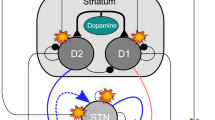Abstract.
The juxtaposition of hypokinetic and hyperkinetic symptoms in Parkinson's disease (PD) presents a challenge in modeling the basal ganglia. We propose a model of the striatum that can account for the mixture of symptoms seen in PD. In the model, the problem of motor planning is cast in terms of a particle in a potential, where potentials are generated internally in striatal modules, subject to afferent control. Planned movement is governed by Hamilton's equations, where potential energy is supplied by potentials expressed in the striatum. To test the model in realistic situations, a dynamic simulation of a two-link robot arm was used. Normal movement is modeled and shown to exhibit observed experimental properties. Symptoms of PD are reproduced by modeling hypothetical consequences of PD pathology.
Similar content being viewed by others
Author information
Authors and Affiliations
Additional information
Received: 17 February 1999 / Accepted in revised form: 21 December 1999
Rights and permissions
About this article
Cite this article
Connolly, C., Burns, J. & Jog, M. A dynamical-systems model for Parkinson's disease. Biol Cybern 83, 47–59 (2000). https://doi.org/10.1007/PL00007971
Issue Date:
DOI: https://doi.org/10.1007/PL00007971




